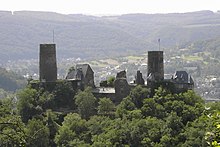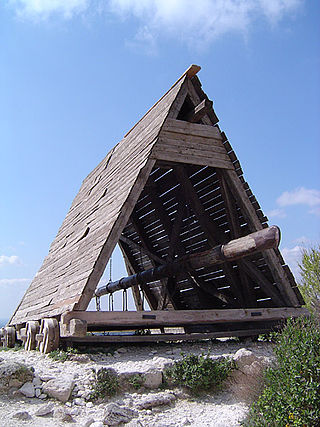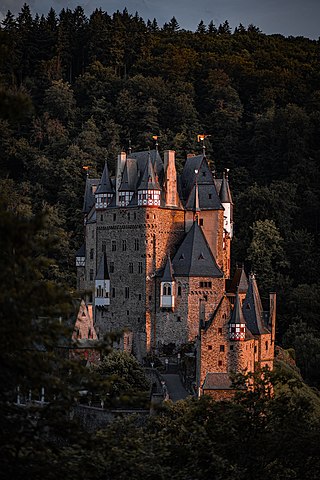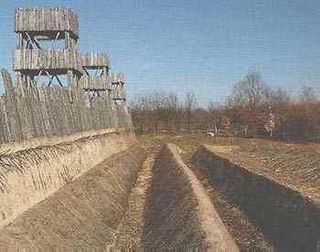
Counter-castles were built in the Middle Ages to counter the power of a hostile neighbour or as a siege castle, that is, a fortified base from which attacks could be launched on a nearby enemy castle.

Counter-castles were built in the Middle Ages to counter the power of a hostile neighbour or as a siege castle, that is, a fortified base from which attacks could be launched on a nearby enemy castle.

In castle science, and according to mediaeval usage, a counter-castle was a type of castle that was built to secure a territorial lord's claims to power or to besiege and conquer the estates of rival rulers. In such cases, it may also be referred to as a siege castle. These terms are not used uniformly by specialist authors. Usually a distinction is made between counter-castles and siege castles. Where this is the case, a siege castle refers to one built near the enemy castle within the range of trebuchets and catapults that could act as a strongpoint, a route barrier, a refuge in the event of counter-attacks, a barracks and a battery position for ballistic weapons.
A counter-castle is often used to describe a castle that was built at a greater distance from enemy fortifications and castles. It did not support the immediate siege of a castle, but was constructed as a base in an area of rival power in order to prevent enemy attempts to expand their influence and control.
Siege castles are only evident from the period of the Late Middle Ages onwards. They were usually built as a temporary fortifications using wood and earth above the castle to be captured and within sight and the range of their guns. From this location the target would be bombarded.
Sometimes only a trebuchet position was established instead of a masonry or wooden siege castle. A favourable point in the terrain, within range of the besieged castle, was levelled and lightly fortified. From this position, the enemy castle could be engaged relatively safely with a trebuchet or catapult and its occupants psychologically ground down. Such a position may be seen today about 430 metres northeast and above Thurant Castle on the Moselle.
Trebuchets were used in sieges from the early 13th century. Large catapults had a range of about 400 to 500 metres. However, only wealthy feudal lords could finance the use of such a large, costly siege engine or even the construction of a counter-castle.

Only occasionally did the attackers have the time and financial resources to build their fortress of stone. Rare examples are Ramstein Castle, the Rauschenburg at Mermuth in the Hunsrück and Trutzeltz Castle. The last-named was built during the Eltz Feud as a counter-castle to Eltz. The Rauschenburg was also built in connection with the Eltz Feud as counter castle to the castles of Ehrenburg, Waldeck and Schöneck.
In the majority of known cases, siege castles were abandoned after the fighting and fell into disrepair. Sometimes the lord of the formerly besieged castle was given the counter-castle in a peace agreement or even took it over as a fief, as in the case of Trutzeltz Castle. In exceptional cases, such structures were - when the conquest was successful - expanded into independent castles. Examples include the Hohenfels and Schadeck Castle at Runkel on the Lahn.
The few surviving stone counter or siege castles generally show evidence of less careful construction. In order to build the fortification quickly, clay was mixed with the lime mortar. These defences are therefore dangerous today in view of their condition and can be made safe through painstaking renovation.
Academic research has only investigated counter and siege castles to any great extent since the end of the 20th century. After scholars like Joachim Zeune had concerned themselves in the 1980s and 1990s more with the symbolism of medieval fortifications, subsequent research began to be more critical of the then established theses. As part of the new focus on the functional and military aspects of military architecture, the counter castle became more of a focus of military historical interest.

The Norman Conquest of England had undergone long preparation and is generally reckoned as one of the most notable military-strategic campaigns of the early High Middle Ages. The Normans attacked the island just at the time when the English were busy defending a Norwegian attack in the north. The English Army under King Harold succeeded in repelling the Vikings but now exhausted, had to fight roughly 7,000 well-equipped Norman warriors.
During the invasion numerous simple 'occupation castles' were built, the first, at Pevensey, being at the landing-place of William's army. In addition to mottes, circular ramparts with palisades were built and older Celtic or Saxon fortifications were reactivated. The wooden components of these wood and earth castles had in some cases been prepared on the continent and were later assembled on the spot. This enabled the rapid establishment of a dense network of military strongpoints, some of which were later turned into stone castles.
These castles can be made out on the famous Bayeux Tapestry. Occasionally even the barrels are depicted in which the invaders transported nails for the construction of forts on the other side of the Channel.


Right at the start of his conquest of Celtic Wales, the English king, Edward I, ordered in 1277 the construction of several castles at strategically important places. Among these early English castles of occupation were those in Aberystwyth, Builth, Flint and Rhuddlan.
The outbreak of new unrest in 1282 caused the king to initiate a huge construction programme. The English Army was accompanied by 355 carpenters, 70 stonemasons, and 1,000 stone breakers and earthworks builders. In addition, 1,700 lumberjacks were gathered from the whole of England. After a year this force was increased by 25 carpenters and 100 stonemasons.
Within a short period of time a complete network of the most modern fortifications sprang up, which are today seen as the epitome of mediaeval profane architecture. With supplies coming in from the sea, these strongpoints enabled the land to be secured militarily. The Welsh castle-building programme cost huge sums of money that had to be raised by parliament and even the church. A subsequent plan to defeat Scotland in the same way foundered due to the cost of such a building campaign.
Among the most important English occupation castles were those of built by James of St. George including Caernarfon, Conway and Harlech.

During the siege of larger, fortified cities and towns castles were sometimes built as protection against sallies and relief troops.
During the First Crusade the Crusaders built the first siege castles before the gates of Islamic towns and cities in the Holy Land. In 1097 Malregard Castle was built in front of the St. Paul's Gate at Antioch. [1] A little later the castles of la Mahomerie and Tancred's Castle were built in front of other gateways.
In 1103 Raymond IV of Toulouse ordered the construction of the siege castle, Mons Pelegrinus, at Tripoli. Raymond was the Count of St. Gilles, which is why the castle in the centre of the town is known locally as Qualat Sandjill.
As well as siege castles, counter-castles were also built at greater distance from the besieged towns. For example, in 1117, King Baldwin I built a counter-castle "ad coercendum praedictam urbem" (to conquer the aforementioned town) of Tyre near İskenderun. Despite this siege Tyre did not fall until 1124.
The king also attempted to monitor the important caravan route of Derb el-Hadj from several new castles. Here the Pilgrim's Way ran to Mecca and Medina. Around Petra the castles of Montreal/Shobaq (1115) and Li Vaux Moisee were built and, in 1116, fortified strongpoints were added at Aqaba and on the Isle de Graye/Jazirat Fara’un.
In 1142, construction started on the mighty fortress of Kerak (Krak de Moab) in northern Transjordan, to which a harbour on the Dead Sea belonged. From here Raynald of Châtillon undertook numerous raids in the surrounding area. In retaliation, Sultan Saladin attacked the Frankish crusader states.
Between 1136 and 1142 four strong castles (at Castrum Arnaldi, Beth Gibelin, Ibelin and Blanchegarde) were built around the Egyptian-held city of Ashkelon.
In the Holy Roman Empire, the term Trutzburg was commonly used to describe the defensive character of a castle that defied all attacks. The word is also used in German as a metaphor for things that are especially durable and resistant.
Where the Trutzburg was built specifically with the object of besieging enemy fortifications it was also known as a Gegenburg ("counter castle"), Okkupationsburg ("occupation castle") or Belagerungsburg ("siege castle"). These terms are used today by modern castle scientists and researchers in preference to the more generic Trutzburg.

A catapult is a ballistic device used to launch a projectile a great distance without the aid of gunpowder or other propellants – particularly various types of ancient and medieval siege engines. A catapult uses the sudden release of stored potential energy to propel its payload. Most convert tension or torsion energy that was more slowly and manually built up within the device before release, via springs, bows, twisted rope, elastic, or any of numerous other materials and mechanisms.

Medieval fortification refers to medieval military methods that cover the development of fortification construction and use in Europe, roughly from the fall of the Western Roman Empire to the Renaissance. During this millennium, fortifications changed warfare, and in turn were modified to suit new tactics, weapons and siege techniques.

A siege is a military blockade of a city, or fortress, with the intent of conquering by attrition, or by well-prepared assault. This derives from Latin: sedere, lit. 'to sit'. Siege warfare is a form of constant, low-intensity conflict characterized by one party holding a strong, static, defensive position. Consequently, an opportunity for negotiation between combatants is common, as proximity and fluctuating advantage can encourage diplomacy. A siege is conducted by siegecraft, or poliorcetics.

A Roman siege tower or breaching tower is a specialized siege engine, constructed to protect assailants and ladders while approaching the defensive walls of a fortification. The tower was often rectangular with four wheels with its height roughly equal to that of the wall or sometimes higher to allow archers to stand on top of the tower and shoot arrows into the fortification. Because the towers were wooden and thus flammable, they had to have some non-flammable covering of iron or fresh animal skins.

A trebuchet is a type of catapult that uses a long arm to throw a projectile. It was a common powerful siege engine until the advent of gunpowder. The design of a trebuchet allows it to launch projectiles of greater weights and further distances than that of a traditional catapult.

A castle is a type of fortified structure built during the Middle Ages predominantly by the nobility or royalty and by military orders. Scholars usually consider a castle to be the private fortified residence of a lord or noble. This is distinct from a mansion, palace and villa, whose main purpose was exclusively for pleasance and are not primarily fortresses but may be fortified. Use of the term has varied over time and, sometimes, has also been applied to structures such as hill forts and 19th- and 20th-century homes built to resemble castles. Over the Middle Ages, when genuine castles were built, they took on a great many forms with many different features, although some, such as curtain walls, arrowslits, and portcullises, were commonplace.

The mangonel, also called the traction trebuchet, was a type of trebuchet used in Ancient China starting from the Warring States period, and later across Eurasia by the 6th century AD. Unlike the later counterweight trebuchet, the mangonel operated on manpower pulling cords attached to a lever and sling to launch projectiles.

A fortification is a military construction or building designed for the defense of territories in warfare, and is also used to establish rule in a region during peacetime. The term is derived from Latin fortis ("strong") and facere.

A siege engine is a device that is designed to break or circumvent heavy castle doors, thick city walls and other fortifications in siege warfare. Some are immobile, constructed in place to attack enemy fortifications from a distance, while others have wheels to enable advancing up to the enemy fortification. There are many distinct types, such as siege towers that allow foot soldiers to scale walls and attack the defenders, battering rams that damage walls or gates, and large ranged weapons that attack from a distance by launching projectiles. Some complex siege engines were combinations of these types.

Eltz Castle is a medieval castle nestled in the hills above the Moselle between Koblenz and Trier, Germany. It is still owned by a branch of House of Eltz who have lived there since the 12th century. Eltz Castle along with Bürresheim Castle and Lissingen Castle are the only ì castles in the Eifel region which have never been destroyed.

A concentric castle is a castle with two or more concentric curtain walls, such that the outer wall is lower than the inner and can be defended from it. The layout was square where the terrain permitted, or an irregular polygon where curtain walls of a spur castle followed the contours of a hill.

Investment is the military process of surrounding an enemy fort with armed forces to prevent entry or escape. It serves both to cut communications with the outside world and to prevent supplies and reinforcements from being introduced.

Bergfried is a tall tower that is typically found in castles of the Middle Ages in German-speaking countries and in countries under German influence. Friar describes it as a "free-standing, fighting-tower". Its defensive function is to some extent similar to that of a keep in English or French castles. However, the characteristic difference between a bergfried and a keep is that a bergfried was typically not designed for permanent habitation.
A Ganerbenburg is a castle occupied and managed by several families or family lines at the same time. These families shared common areas of the castle including the courtyard, well, and chapel, whilst maintaining their own private living quarters. They occurred primarily in medieval Germany.

"Zwinger" is a German word for outer ward or outer bailey. It represents an open kill zone area between two defensive walls that is used for defensive purposes. Zwingers were built in the post-classical and early modern periods to improve the defence of castles and town walls. The term is usually left untranslated, but is sometimes rendered as "outer courtyard", presumably referring to the subsequent role of a Zwinger as a castle's defences became redundant and it was converted into a palace or schloss; however, this belies its original purpose as a form of killing ground for the defence. The word is linked with zwingen, "to force", perhaps because the Zwinger forced an enemy to negotiate it before assaulting the main defensive line. Essenwein states that the "main purpose of this feature was so that the besieging force could not reach the actual castle wall very easily with battering rams or belfries, but had to stop at the lower, outer wall; also that two ranks of archers, behind and above one another, could fire upon the approaching enemy".

The Eltz Feud was a 14th-century feud that arose between rulers of the Trier region on the Moselle and certain members of the knightly class who were acting independently and failing to support their sovereign princes. It came about as a result of attempts in 1331 by the Archbishop of Trier and Elector Baldwin of Luxembourg to re-incorporate the imperial ministeriales or knights of the castles of Ehrenburg, Eltz, Schöneck and Waldeck as vassals into the administrative district of Trier and to subordinate them to a unified, sovereign state administrative structure. Their distance from the power of the imperial government and a weak predecessor of Archbishop Baldwin had allowed the knights to acquire autonomy and rights supposedly under the law of custom, even though they were already vassals and fief holders of the Archbishop.

The Rauschenburg, also called Rauschenburg Castle, is the medieval ruin of a hill castle, located at around 250 metres above sea level, above the Ehrbach stream in the parish of Mermuth in the county of Rhein-Hunsrück-Kreis in the German state of Rhineland-Palatinate.

The ruins of Trutzeltz Castle, also known as Balduineltz, Baldeneltz or Neueltz, are the remains of a hill castle in the valley of the Elz in the parish of Wierschem near the town of Münstermaifeld. It was built as a counter-castle during the medieval Eltz Feud in the Moselle region.

A removable roof was an easily dismantled construction that protected the curtain walls, cavaliers and bastions of several early modern European fortresses. It was once believed that this construction was as old as the 12th century, but most modern historians maintain that the first removable roofs were constructed around 1550.